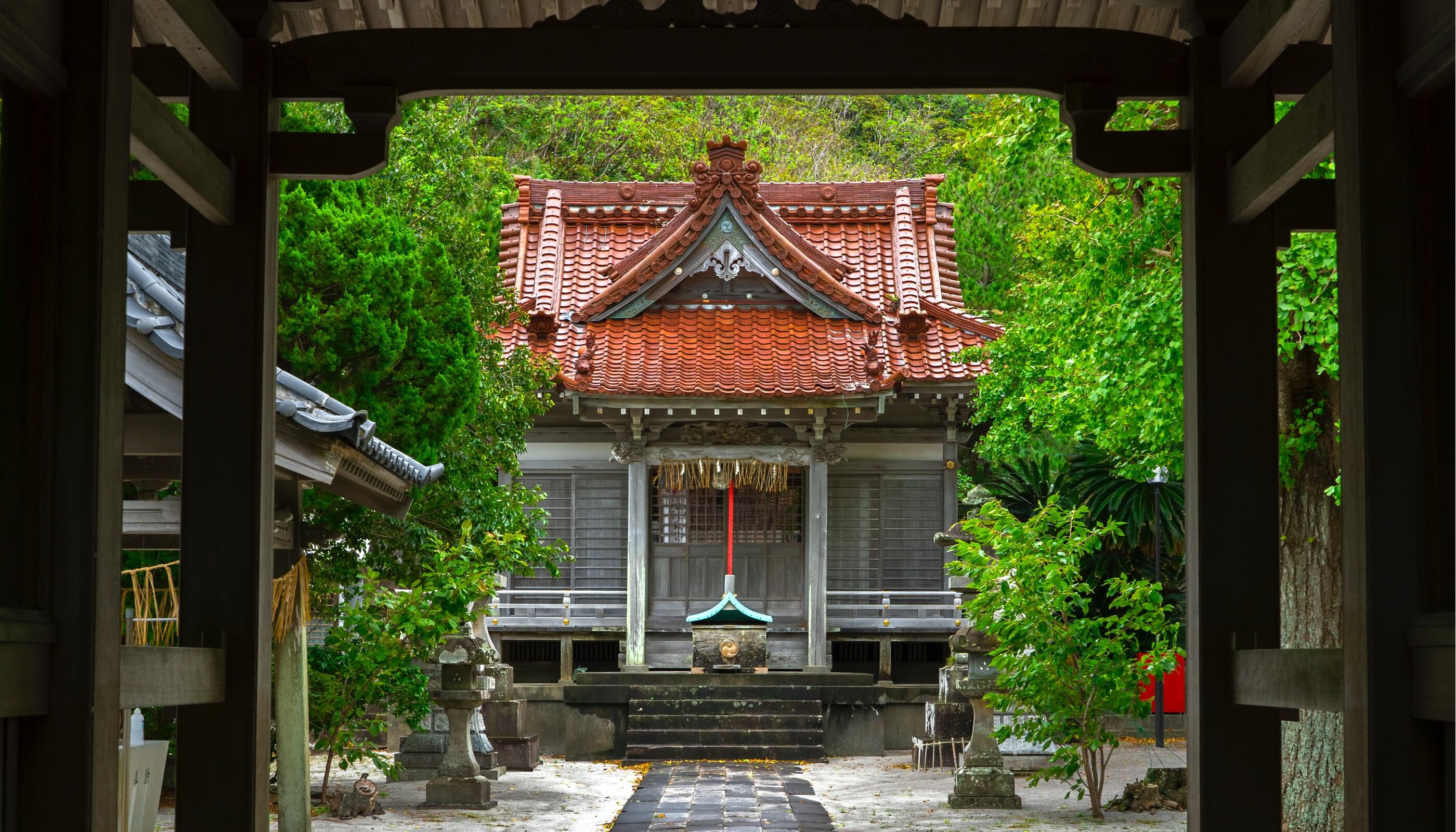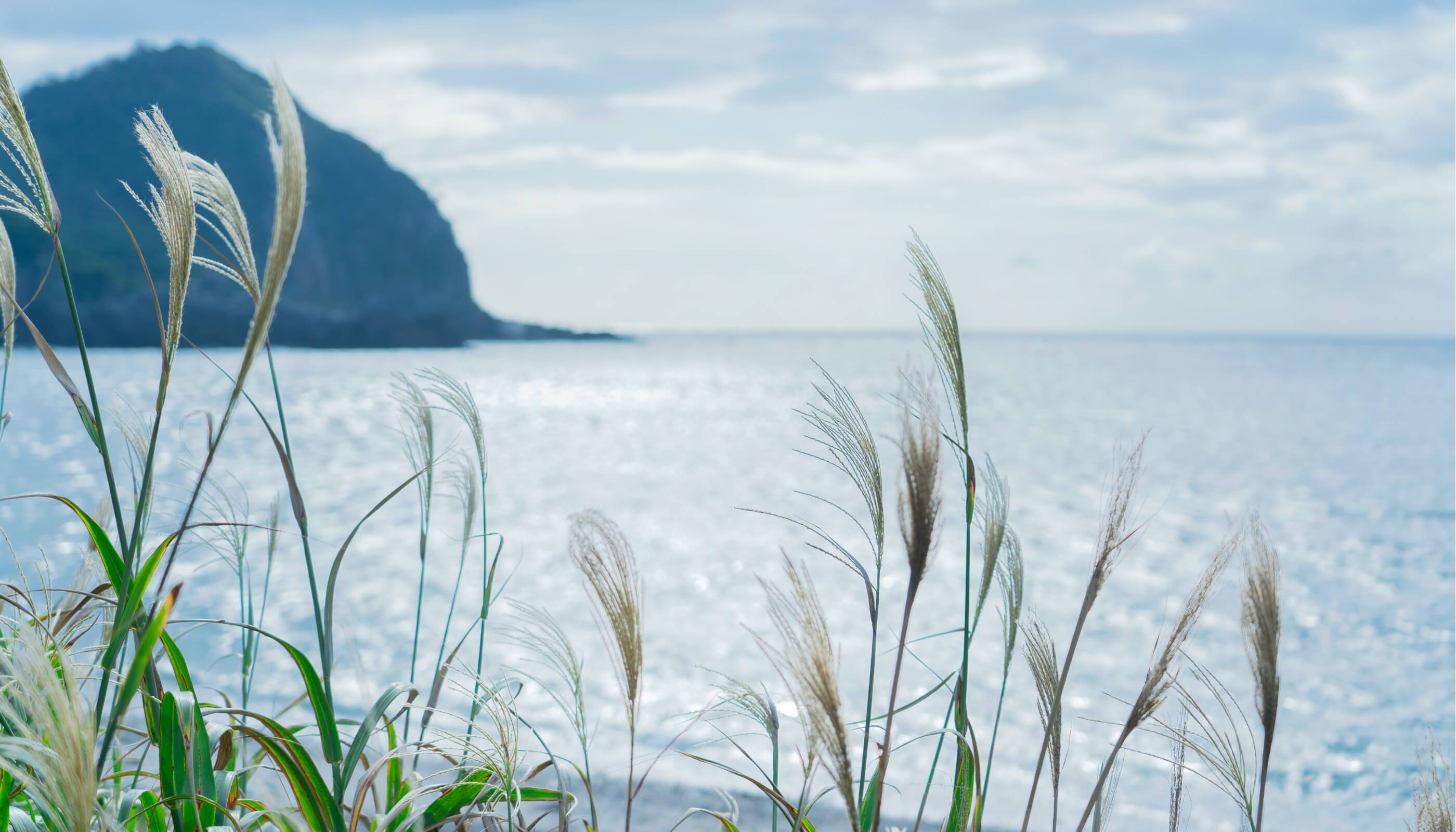Kozushima Island used to be written as “the island where gods gather”.
It originates from the legend that a god called Kotoshironushi-no-Mikoto gathered gods and consulted on the creation of Izu islands.
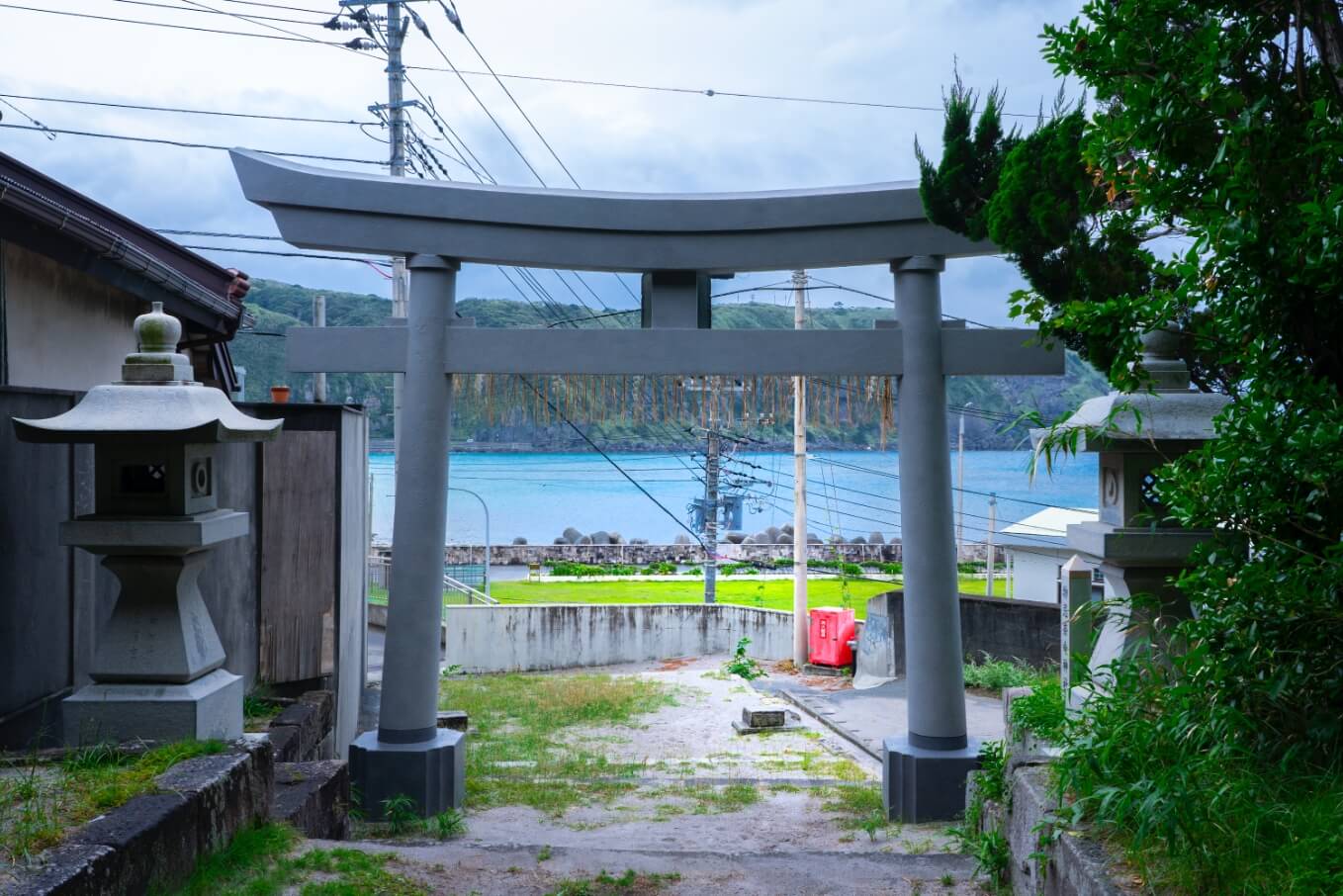
Awa-no-Mikoto-jinja Shrine, which enshrines the empress of Kotoshironushi-no-Mikoto has a custom of offering small stones called “Shiobana”, filled with sand washed by the waves at torii gates.
In ancient times, it was believed that gods came from the sea and stayed in the sand and pebbles on the beach.
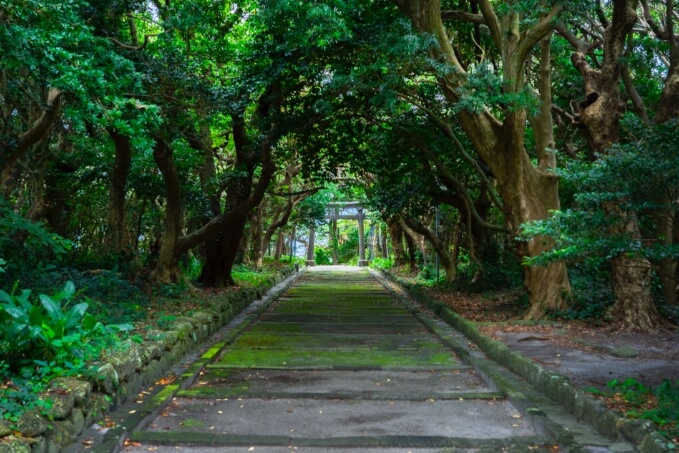
Kozushima Island has a long history and tradition derived from mythology, and people’s beliefs are rooted there.
Please spend your time at Kozushima, the island where the gods gather.
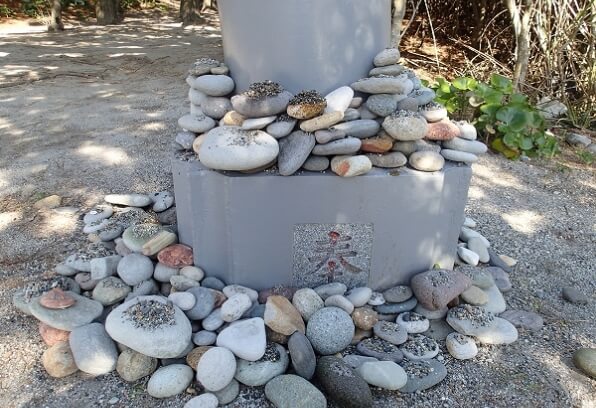
Where Did the Gods of
Kozushima Island Come From?
Monoimina-no-Mikoto-jinja Shrine and Awa-no-Mikoto-jinja Shrine in Kozushima are two prestigious Shikinai Myojin Taisha.
The enshrined god has a deep connection with the god of Izu.
Myojin Taisha Shrines
in Kozushima Island
Only Two Shrines in Tokyo,
Monoimina-no-Mikoto-jinja Shrine and
Awa-no-Mikoto-jinja Shrine
There are three shrines in Kozushima Island that are maintained by Shinto priests and shrine parishioner organizations.
- Monoimina-no-Mikoto-jinja Shrine
- Awa-no-Mikoto-jinja Shrine
- Hyuga-jinja Shrine
Among them, Monoimina-no-Mikoto-jinja Shrine and Awa-no-Mikoto-jinja Shrine are Shiki-nai Myojin Taisha. “Shiki-nai” refers to the shrines listed in the “Engi-shiki Jinmyocho” (a list of important shirines), which was roughly completed in 927 Myojin Taisha is one of the shrine rankings of ancient shrines, and it is said to be a shrine enshrining a Myojin, a god that has been remarkably miraculous since ancient times.
Of the 2861 shrines listed in the “Engi-shiki Jinmyocho” across Japan, only about 220 were granted Myojin Taisha, and in Tokyo there are only 2 Myojin Taisha, Monoimina-no-Mikoto-jinja Shrine and Awa-no-Mikoto-jinja Shrine located on Kozushima Island.
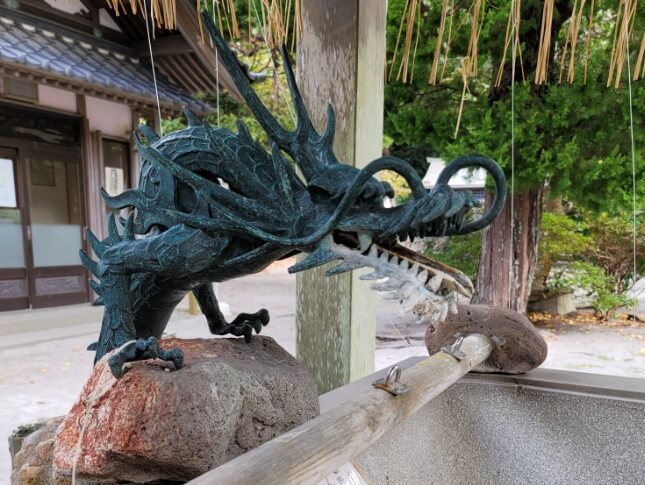
Shrines Dedicated to Kotoshironushi-no-Mikoto’s Empress and Firstborn Child
Monoimina no mikoto is the eldest child of Kotoshironushi-no-Mikoto and Awanome-no-Mikoto is his empress.
Kotoshironushi-no-Mikoto is the eldest child of Okuninushi-no-Mikoto who is known as the god of marriage, and is said to be the god who built Izu island based on Izu Peninsula.

Three Shrines
in Kozushima Island
The three shrines of Monoimina-no-Mikoto-jinja Shrine, which enshrines the eldest child of Kotoshironushi-no-Mikoto, Awa-no-Mikoto-jinja Shrine, which enshrines the empress god, and Hyuga-jinja Shrine, which enshrines the second child of Kotoshironushi-no-Mikoto, are maintained by the devout faith of Shinto priests and shrine parishioner on the island.
Monoimina-no-
Mikoto-jinja Shrine
The Island’s Guardian God Known as “Myojin sama”
- Founded
- Unknown
- Location
- Maehama Port
- Shrine ranking
- Shiki-nai Myojin Taisha
- The enshrined deity
- Monoimina-no-Mikoto
- Common name
- Myojin sama
- Annual festival date
- August 1
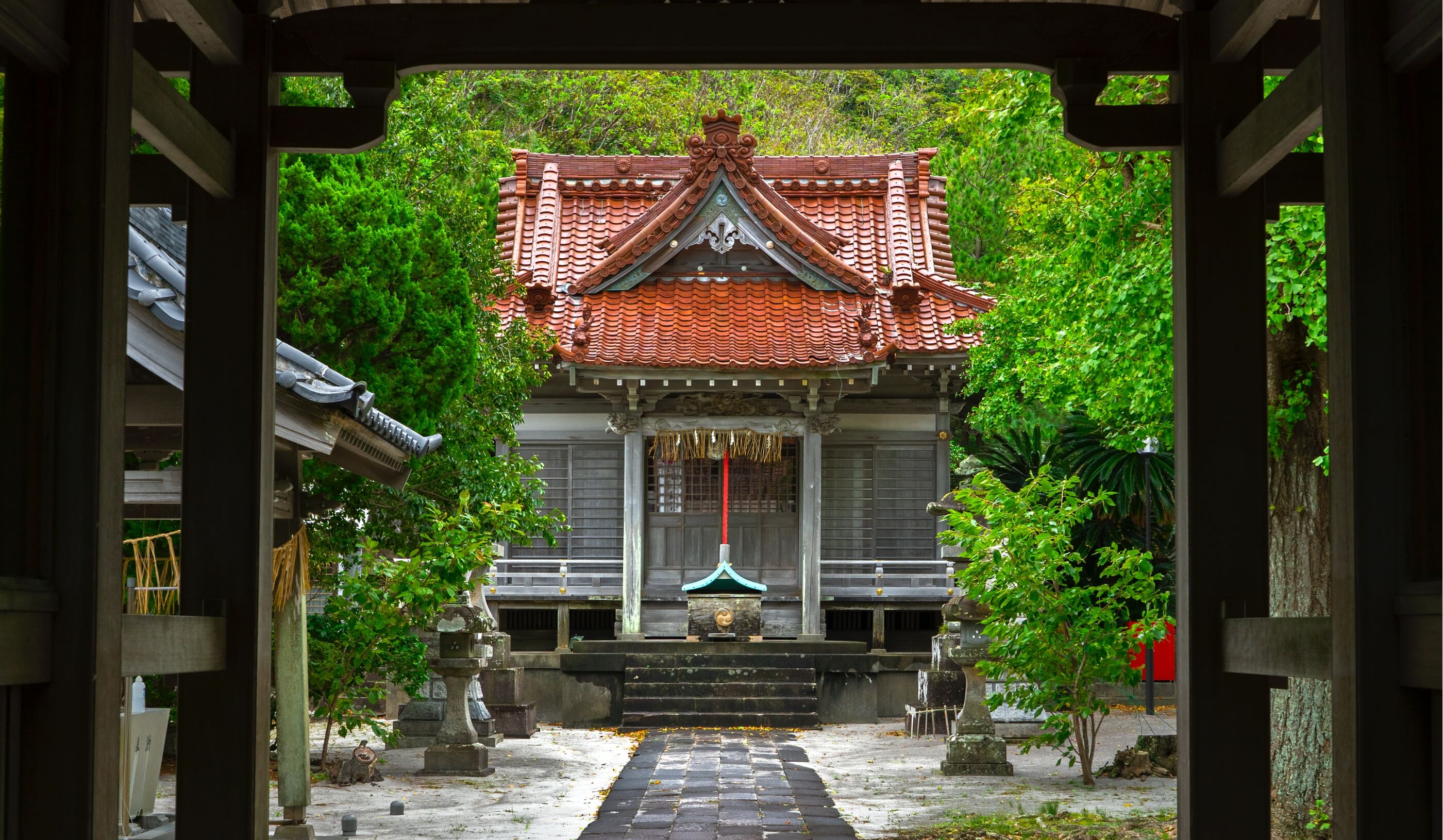
Shiki-nai Myojin Taisha
The enshrined deity, Monoimina-no-Mikoto, is the eldest child of Kotoshironushi-no-Mikoto, and his mother is Awanome-no-Mikoto. Kotoshironushi-no-Mikoto is the eldest son of Okuninushi-no-Mikoto, who is known as the god of marriage, and is said to be the god who built Izu Island on the Izu Peninsula. Because of the deep relationship with Kotoshironushi-no-Mikoto, Monoimina-no-Mikoto-jinja Shrine is a prestigious shrine that is listed in the Shiki-nai Myojin Taisha along with Awa-no-Mikoto-jinja Shrine that enshrines the mother god. In Tokyo, there are only two Myojin Taisha, Monoimina-no-Mikoto-jinja Shrine and Awa-no-Mikoto-jinja Shrine located in Kozushima Island.
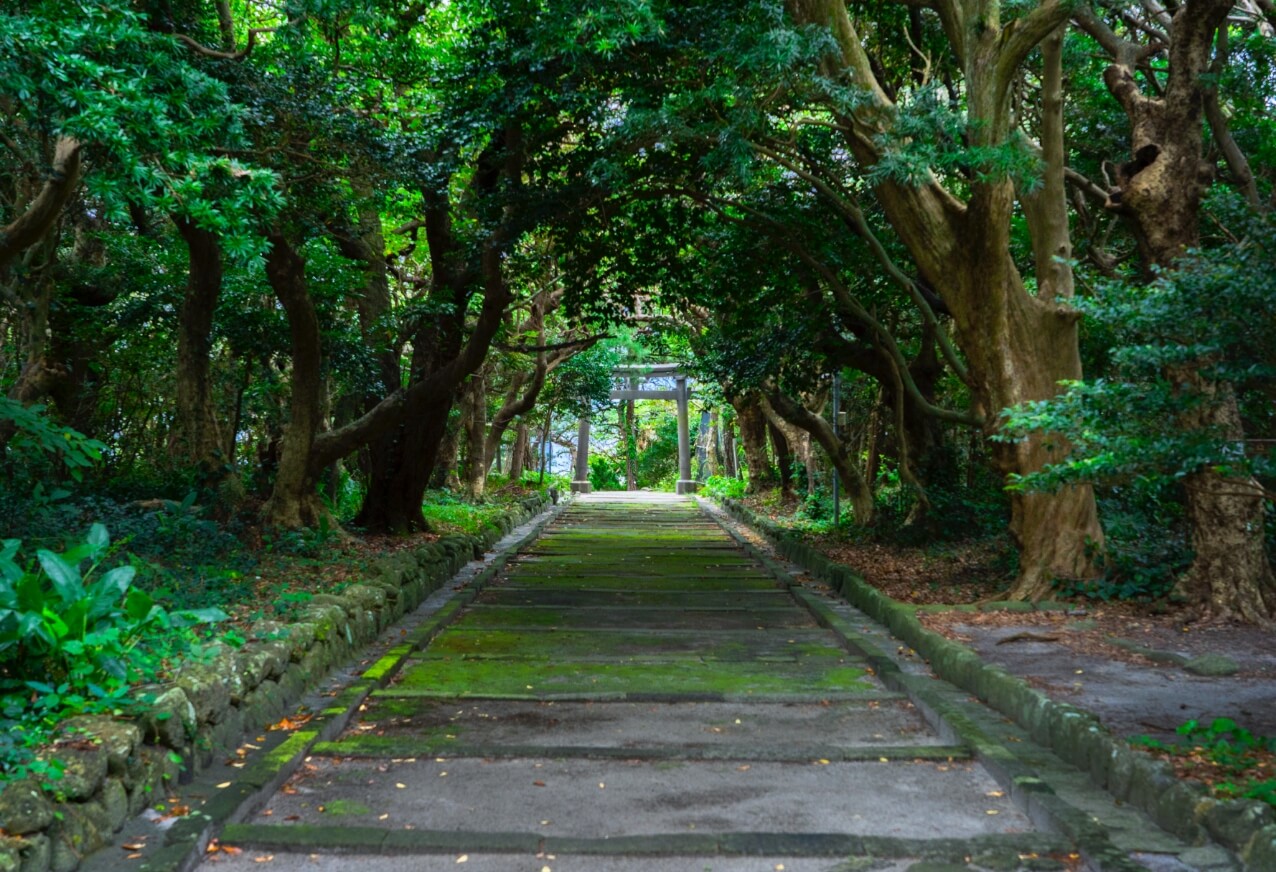
Worship from the Front Shrine
When you pass through the Zuishin-mon Gate, where the guardian gods are placed, there is a haiden(worship hall) in front of you, from which visitors greet the gods. Behind the haiden stands the honden (main hall), and inside the honden stands the naiku (inner shrine), where the goshintai (object of worship housed in a Shinto shrine and believed to contain the spirit of a deity) is housed.
*The main shrine is off-limits.
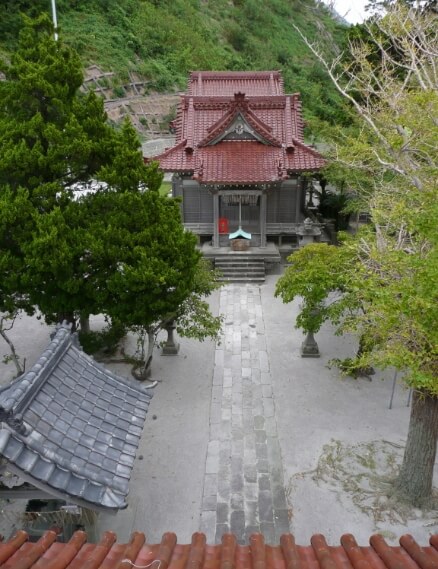
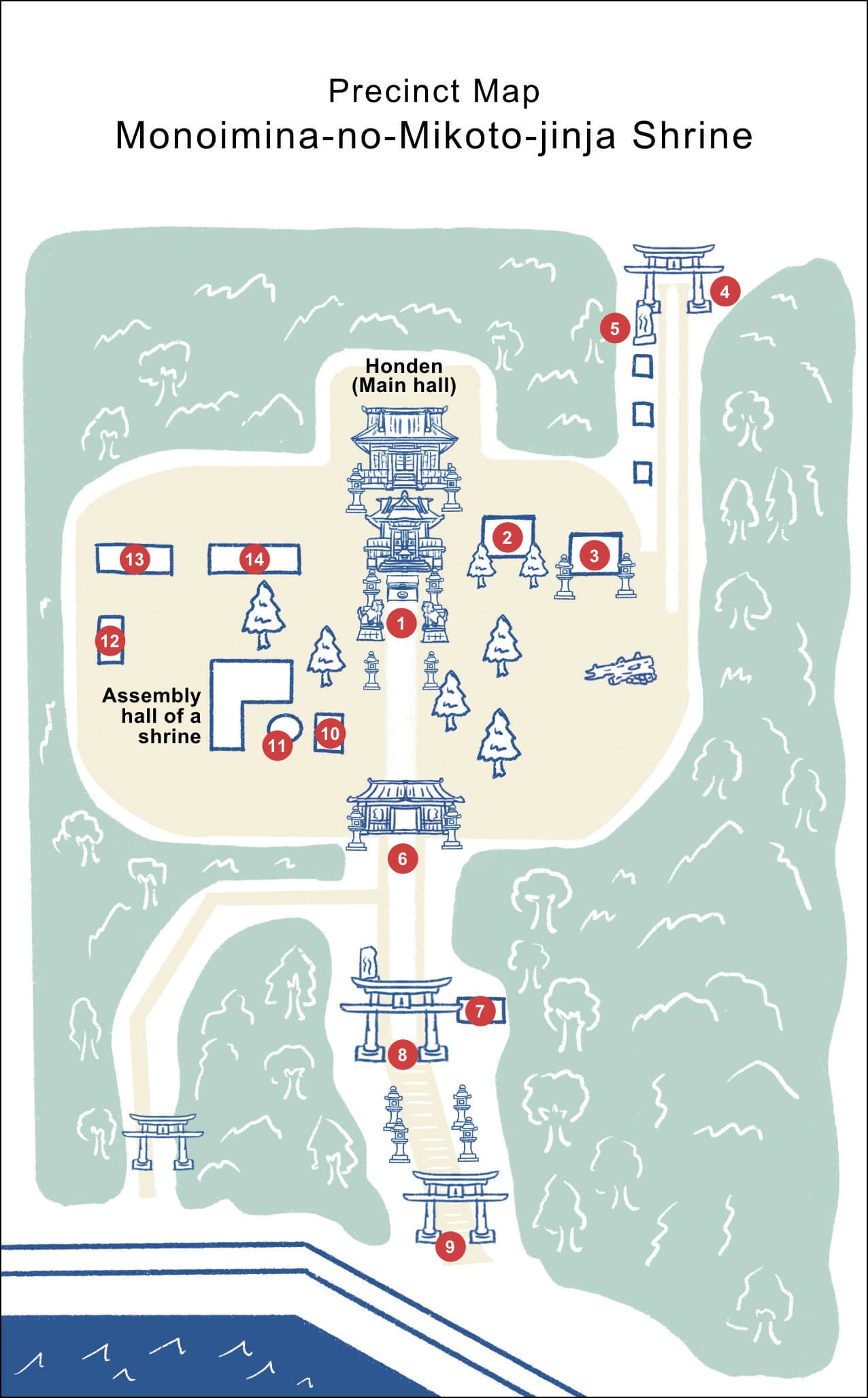
To view the photos, click the number button below.
- Haiden (Worship hall)
- Warehouse for Storing Mikoshi (portable shrine)
- Yakuoden(Yakushi Nyorai, Medicine Buddha is enshrined here)
- Ura-mon(Back gate)
- Stone Monument to Pray for a Good Catch of Fish
- Zuishin-mon Gate(The guardian gods are placed here)
- Rokudaiten-jinja Shrine
- The Second Torii Gate
- The First Torii Gate
- Temizusha (Main purification font)
- Wisteria Trellis Estimated 100 Year-old
- Megami-sama(God of healing of eye disease)
- Massha(Small shrine attached to the main shrine)
- Massha(Small shrine attached to the main shrine)
Shinto Rituals of
Monoimina-no-Mikoto-jinja Shrine
The annual festival of Monoimina-no-Mikoto-jinja Shrine is held on August 1 every year. The “Katsuo-tsuri Shinji(bonito fishing ritual)” held on the following day, August 2, started in the era of Ienari, the 11th Shogun in the late Edo period and is designated as an Important Intangible Folk Cultural Property. In the past, fishermen in Kozushima Island used to thank God that they were able to catch bonitos in rough seas by hand using 4-cho yagura and so on and return safely. The “bonito fishing ritual” derives from this and is a fun event that recreates the ancient style of bonito fishing, in which fishermen run around and fish the islanders, likening them to bonito.
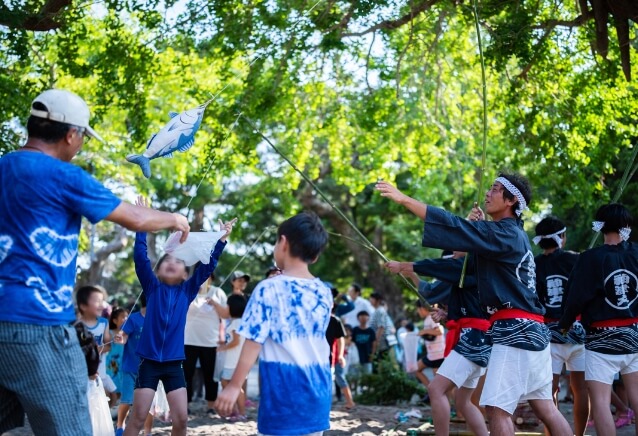
Awa-no-Mikoto-jinja Shrine
A Shrine that Enshrines Kotoshironushi-no-Mikoto’s Empress Deity “Nagahama sama“
- Founded
- Unknown
- Location
- Behind Nagahama Coast
- Shrine ranking
- Shiki-nai Myojin Taisha
- The enshrined deity
- Awanome-no-Mikoto
- Common name
- Nagahama sama
- Annual festival date
- April 15
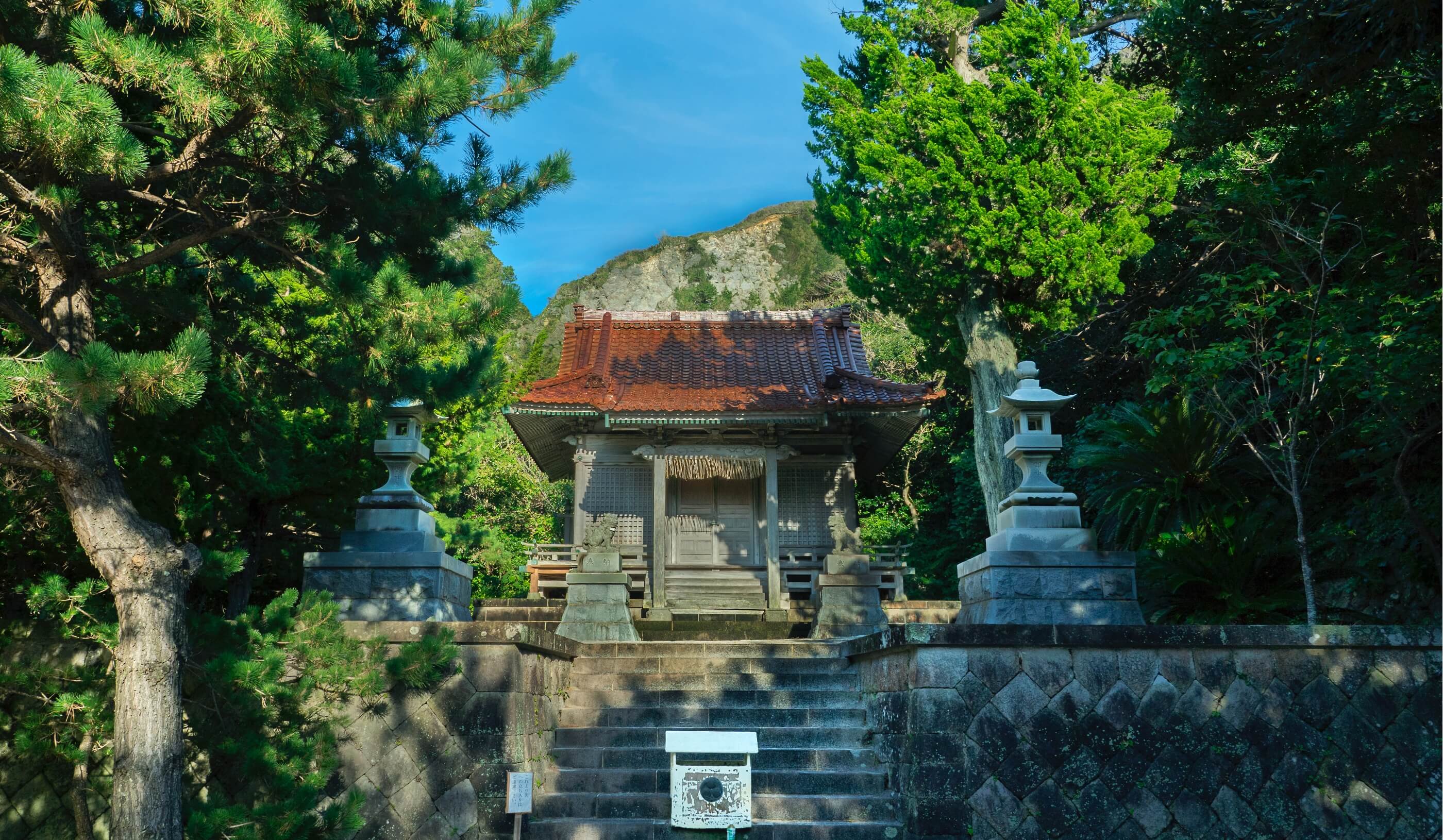
Kotoshironushi-no-Mikoto’s Empress
Awanome-no-Mikoto, the enshrined deity, was considered the real empress among the eight empress gods of Kotoshironushi-no-Mikoto and was a high-status goddess. However, although Ikonahime-no-Mikoto, who was the second consort of the Emperor, was given the crown rank, but Awanome-no-Mikoto, the real consort was not. Therefore, she got angry and Mt. Tenjo erupted in 838, according to “Shoku Nihon Koki” (Later Chronicle of Japan, Continued). After that, Awanome-no-Mikoto and her son, Monoimina-no-Mikoto were granted the crown by the Imperial Court, and they are said to have maintained a high shrine ranking as gods with a deep connection to Kotoshironushi-no-Mikoto. Like Monoimina-no-Mikoto-jinja Shrine, Awa-no-Mikoto-jinja Shrine is listed as Shiki-nai Myojin Taisha.
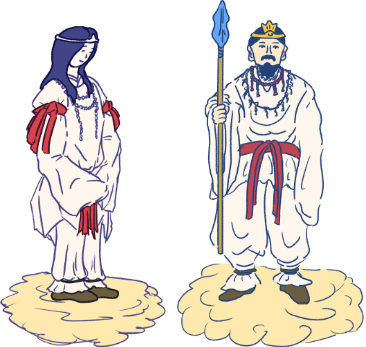
Nagahama Coast (Goshiki-hama Coast)
Nagahama Coast, where Awanome-no-Mikoto is enshrined, is located about 3 kilometers north of the center of the island. As the name suggests, it is a long beach with blue, red, yellow, black, and white colored cobblestones on the coast, and is also called “Goshiki-hama”. In Goshiki-hama Coast, there is a legend that Awanome-no-Mikoto, who was jealous of Kotoshironushi-no-Mikoto’s having empresses here and there, took away the empresses’ jewels and made them into cobblestones, and even now, there is a legend that if you bring stones from the beach, you will be punished by the gods.
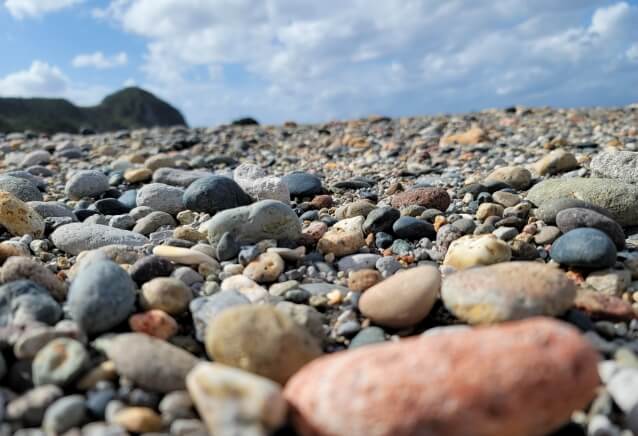
Shiobana (tide flowers) representing gods
Flat pebbles filled with sand washed by the waves are placed on the Torii Gate of Awa-no-Mikoto-jinja Shrine at the back of Nagahama Coast and on the steps in front of the honden (main hall). This is called “Shiobana,” and there is a custom to offer it when praying for a good catch or for the safety of sailing. They say, “In ancient times, gods were believed to come from the sea, and gods were believed to barricade themselves in the sand and pebbles on the seashore, and these were offered to gods, and the Shiobana represented gods.”
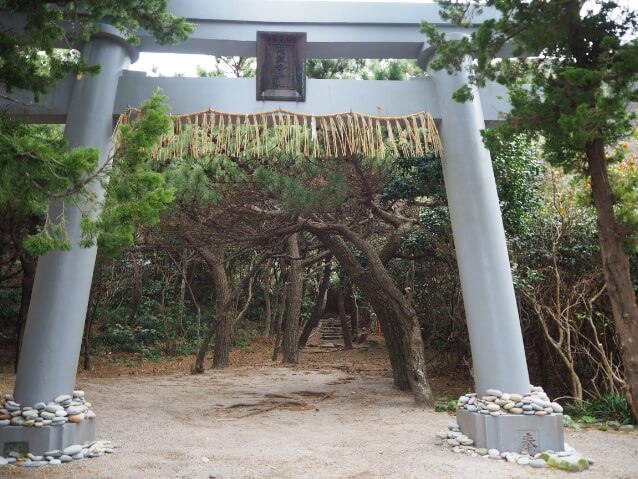
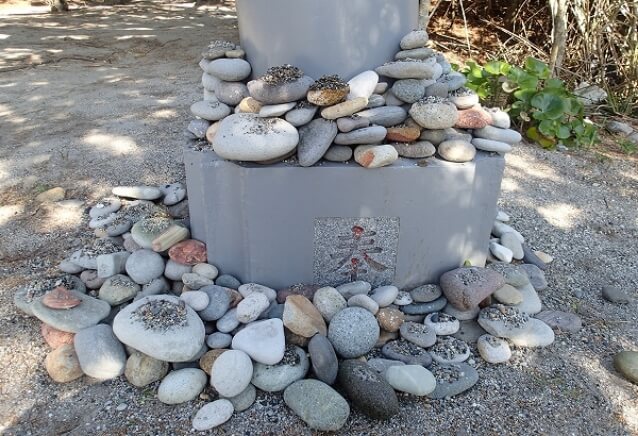
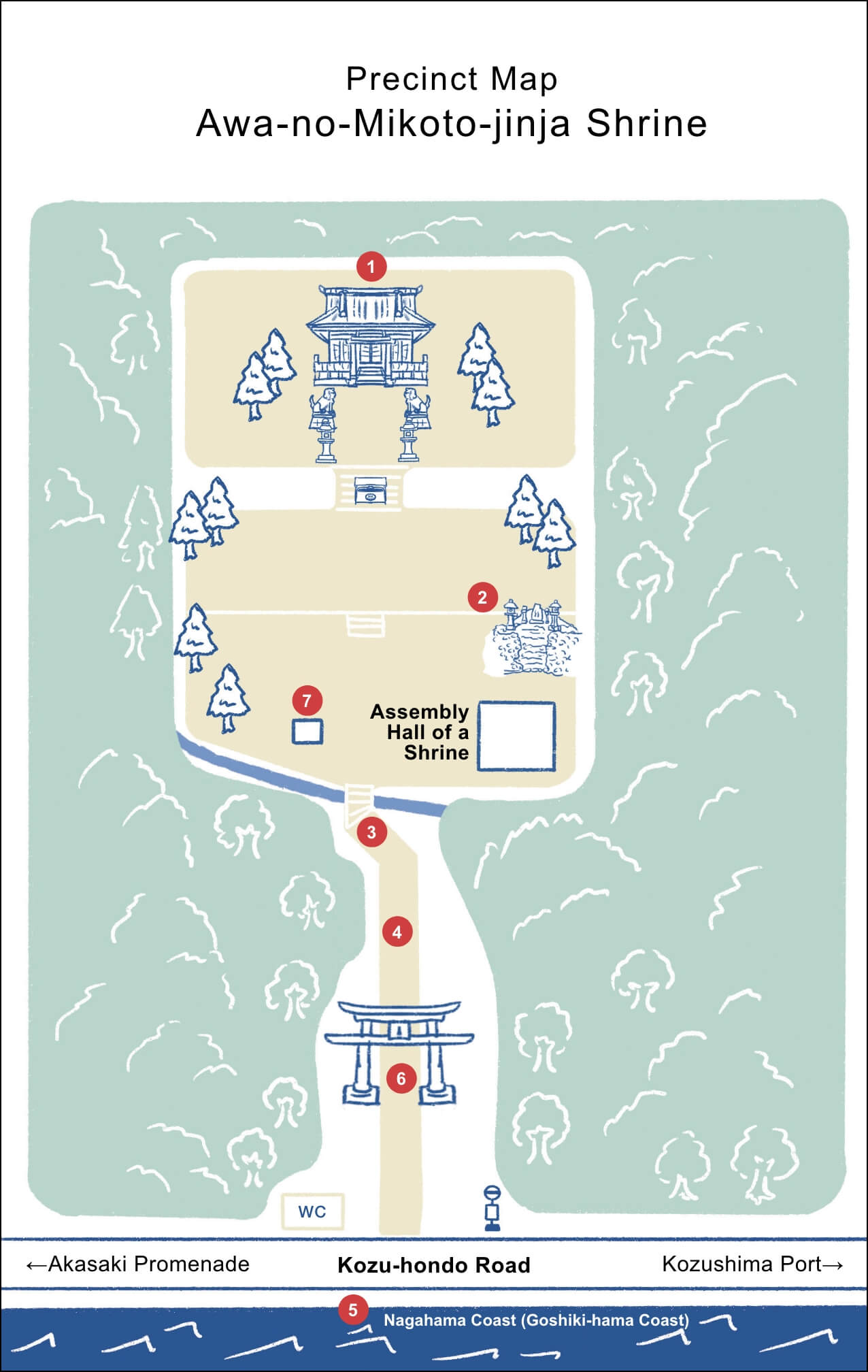
To view the photos, click the number button below.
Hyuga-jinja Shrine
A shrine on the Takowan Bay that enshrines the younger brother god of Monoimina-no-Mikoto
- Founded
- Unknown
- Location
- Takowan Bay
- Shrine ranking
- ー
- The enshrined deity
- Tonae-no-Oji
- Common name
- Hyuga sama
- Annual festival date
- November 15
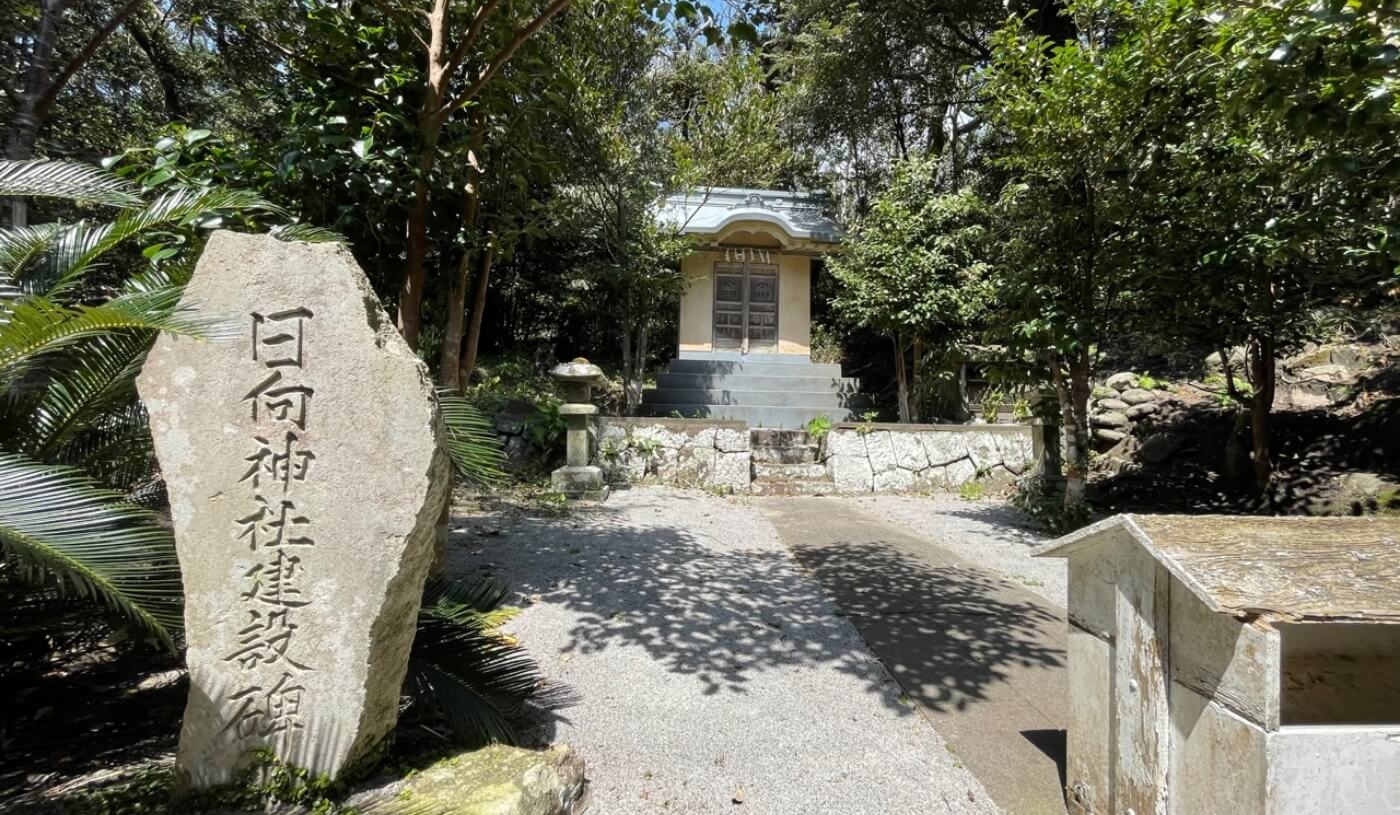
The second child of Awanome-no-Mikoto who died young
Details such as the foundation and establishment of Hyuga-jinja Shrine are unknown, but “Miyake-ki”, a collection of legends of Miyakejima Island, completed in the Kamakura period, states that Mishima Daimyojin had his empress called “Nagahama no Gozen of Kozushima Island” and had two sons, Monoimina-no-Mikoto and Tonae-no-Oji. “Nagahama no Gozen” refers to Awanome-no-Mikoto. “Tonae-no-Oji” is the enshrined deity of Hyuga-jinja Shrine, and there is a description that he died young. Monoimina-no-Mikoto-jinja Shrine, Awa-no-Mikoto-jinja Shrine, and Hyuga-jinja Shrine all enshrine gods that are said to be related to Mishima Taisha Shrine.
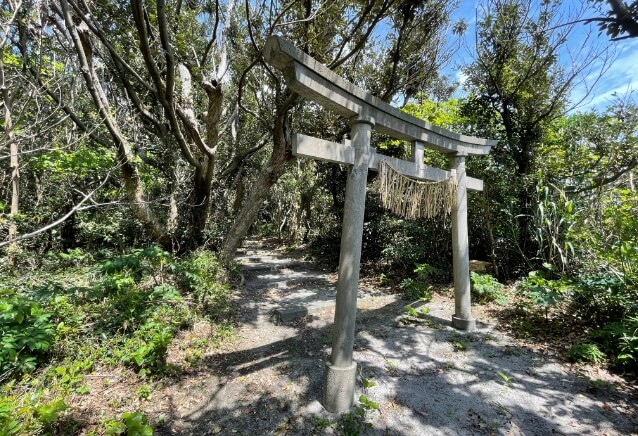
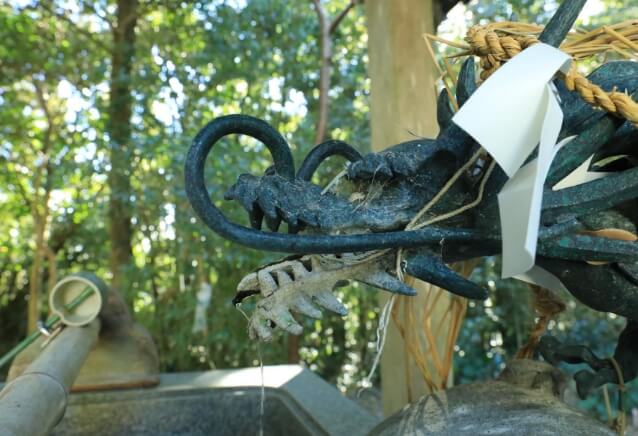
A spot where you can
feel the faith of
Kozushima Island
There have been many myths about Kozushima Island since ancient times, but one of the most famous is The Legend of Water Sharing of Izu Islands. There are many spots where you can feel the depth of faith of the people of Kozushima Island, such as Hairanaigasawa, which is related to this legend, Sarutahiko-no-Okami, worshiped in connection with an event called “Nijugonichi sama”, and Kozu 100 Kannon Pilgrimage.
-
- Monoimina-no-Mikoto-jinja Shrine
-
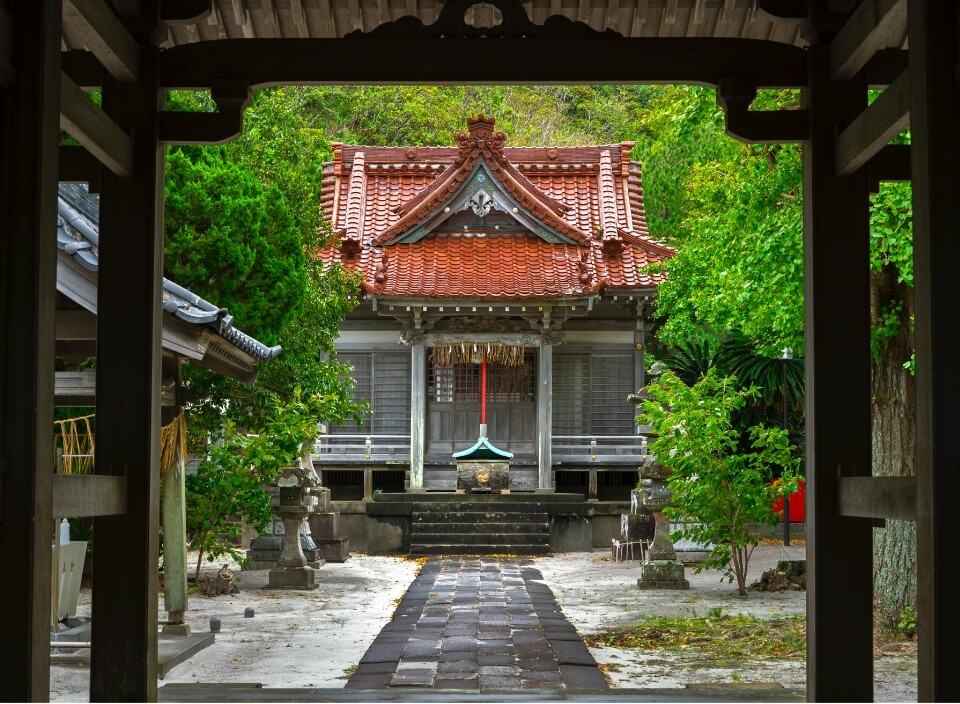
Shiki-nai Myojin Taisha which is the main shrine in Kozushima Island./1 minute walk from Macchare Center.
-
- Awa-no-Mikoto-jinja Shrine
-

Along with Monoimina-no-Mikoto-jinja Shrine, there are only two Shiki-nai Myojin Taisha in Tokyo./17 minutes by car from Macchare Center.
-
- Hyuga-jinja Shrine
-

A shrine on the coast of Tako Bay that enshrines Monoimina-no-Mikoto’s younger brother god Tonae-no-Oji./10 minutes by car from Macchare Center to Tako Bay Campground. From there it is a 10 minute walk.
-
- Statue of The Legend of Water Sharing
-

A monument that tells of The Legend of Water Sharing at Maehama Beach./2 minutes’ walk from Macchare Center.
-
- Tako Bay Spring Water
-
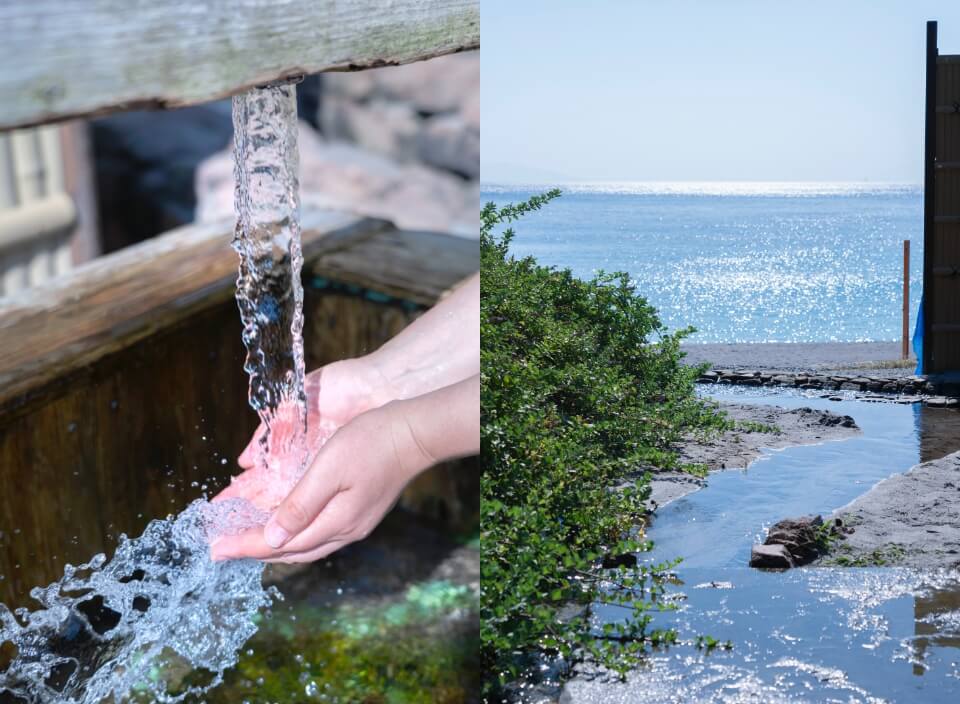
A spot that symbolizes the richness of water in Kozushima Island and is one of “Tokyo’s Famous Spring Water 57”./10 minutes by car from Macchare Center.
-
- Mt. Tenjo
-
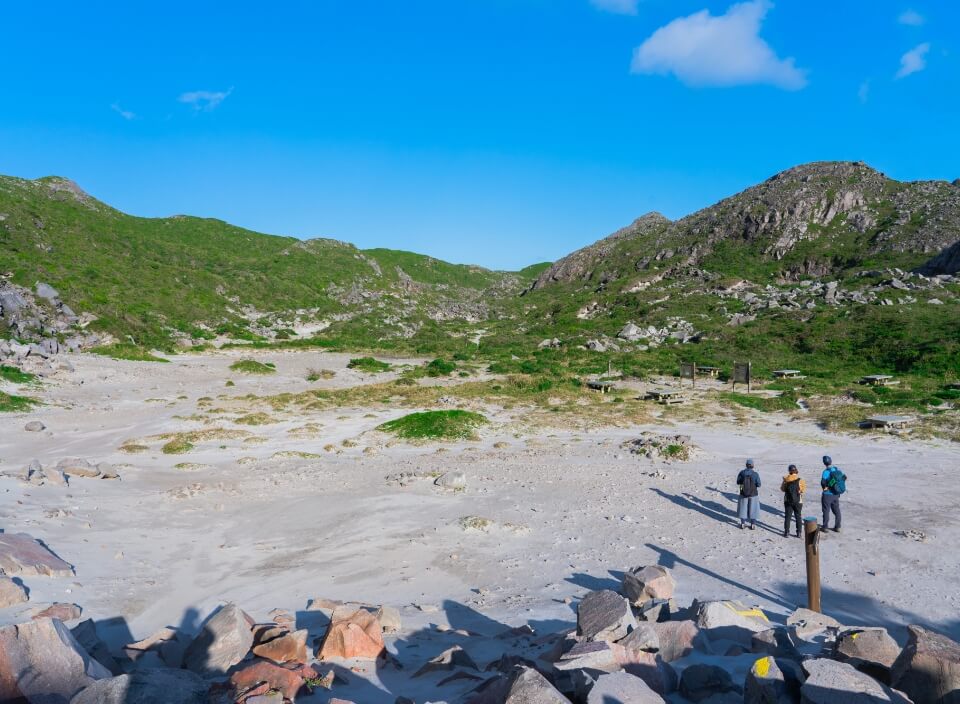
It is a trapezoidal mountain 572 meters above sea level, and is said to be the stage of The Legend of Water Sharing of Izu Islands./6 minutes by car from Macchare Center to Kuroshima Mountain Path.
-
- Hairanaigasawa
-
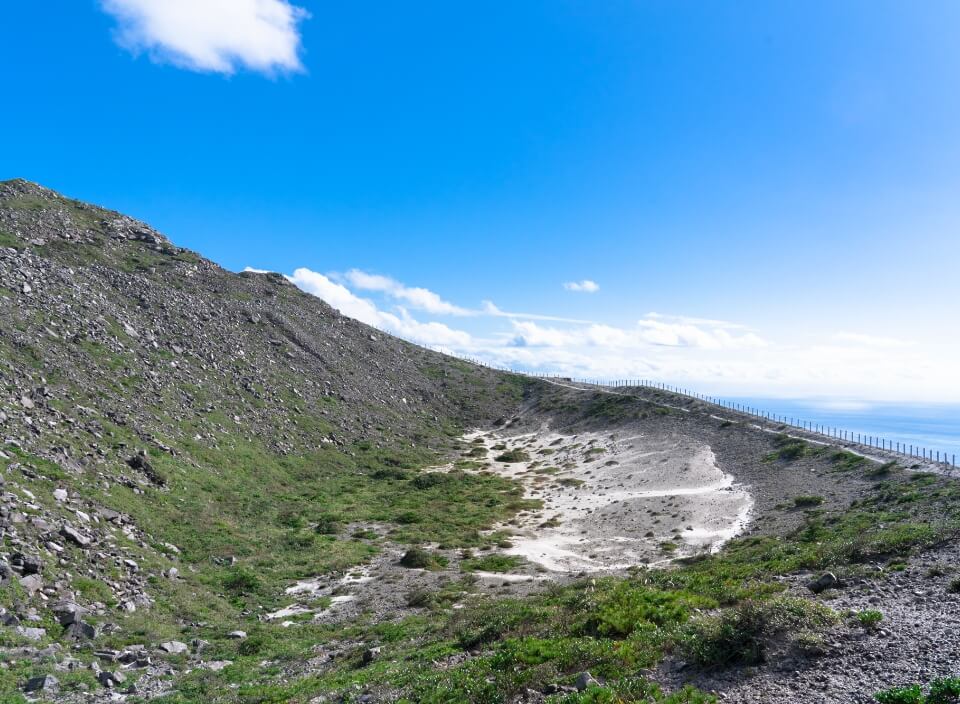
It is a sacred place on Mt. Tenjo and is not allowed to enter./It takes 6 minutes by car from Macchare Center to Kuroshima Mountain Path. From there it is a 90 minute walk.
-
- Fudo Pond
-
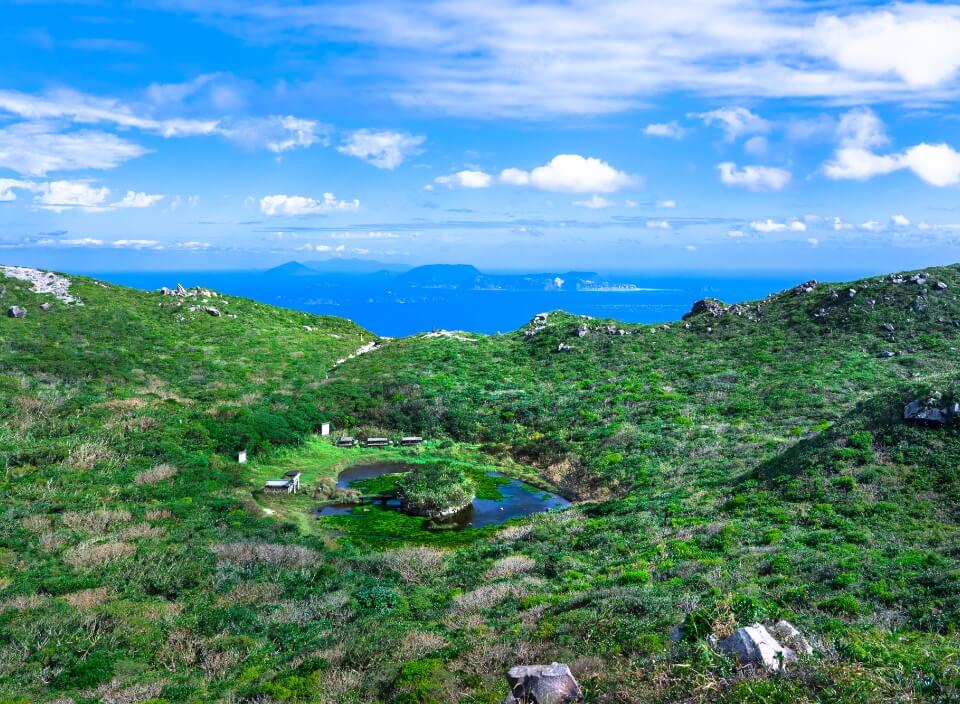
A heart-shaped pond on Mt. Tenjo. There was a shrine dedicated to Ryujin-sama, and it was worshipped by fishermen./It takes 6 minutes by car from Macchare Center to Kuroshima Mountain Path. From there it is a 90 minute walk.
-
- Nagahama Coast (Goshiki-hama Coast)
-
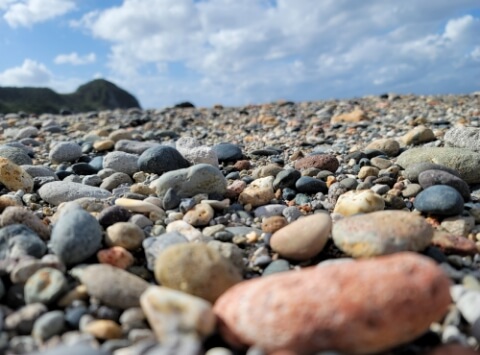
a beach known for its colorful cobblestones. It is also called Goshiki-hama Coast./17 minutes by car from Macchare Center.
-
- Kannondo
-
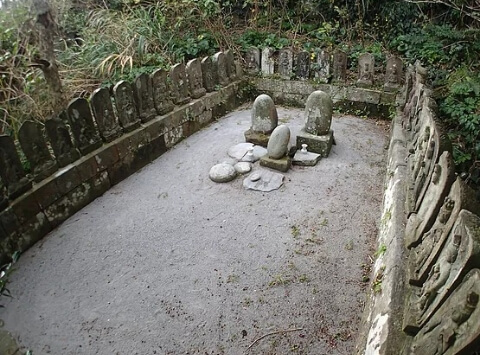
It is one of the Kozu 100 Kannon Pilgrimage stops and was modeled after the Saigoku 33 Kannon Pilgrimage by former islanders./45 minutes by car from Macchare Center to the end of the forest road. An hour’s walk from there.
-
- Chichibudo
-
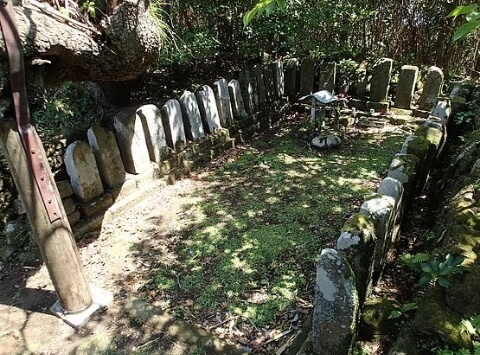
It is one of the Kozu 100 Kannon Pilgrimage stops and is a place that was modeled after Chichibu 34 Kannon Sanctuary built by former islanders./60 minutes walk from Macchare Center.
-
- Tonori-no-Anyado
-
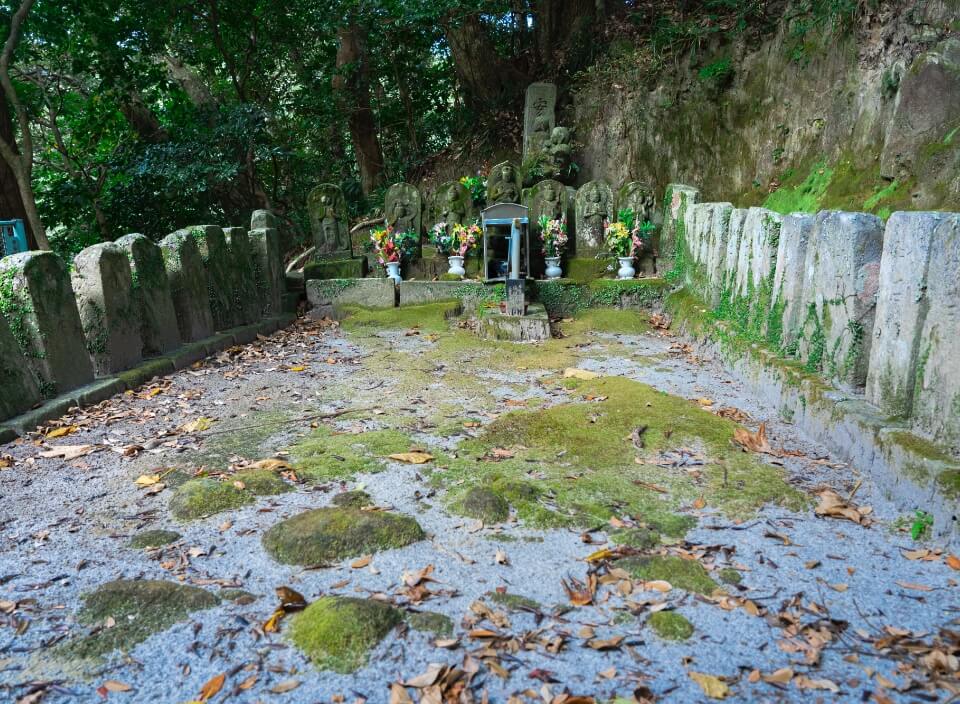
It is one of the Kozu 100 Kannon Pilgrimage stops. The original “Bando 33 Kannon Pilgrimage” was built by Minamoto no Yoritomo. 30 minutes walk from Macchare Center.
-
- An area where many Sarutahiko-no-Okami can be seen
-
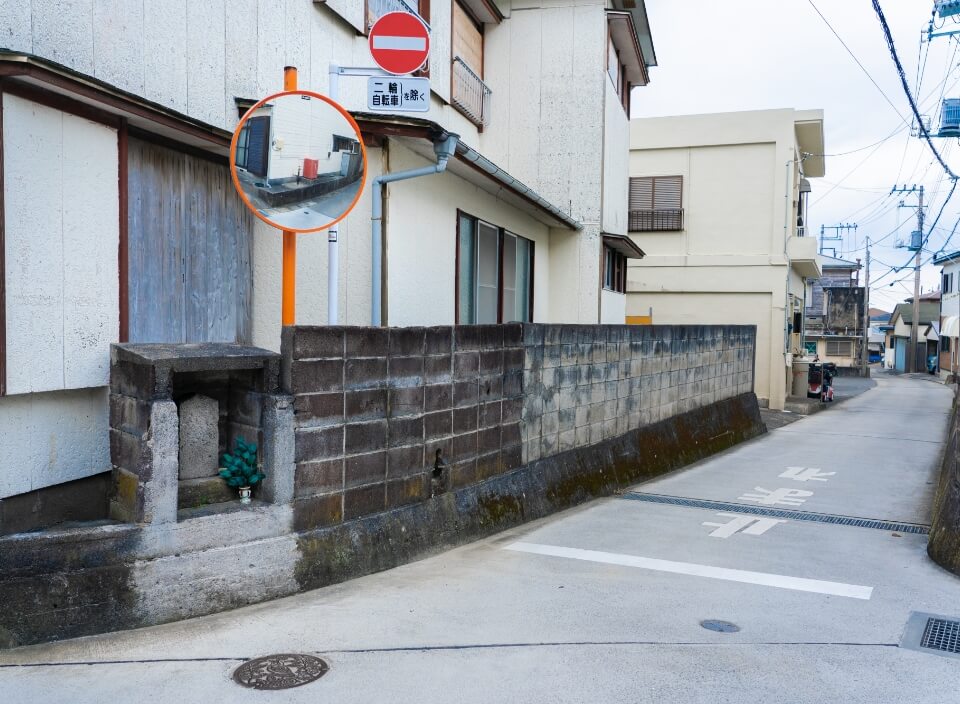
Dososhin(The Wayside Gods) is mainly enshrined at the three-forked road in the village, and it is said that there are 27 of them on the island./10 minutes walk from Macchare Center.
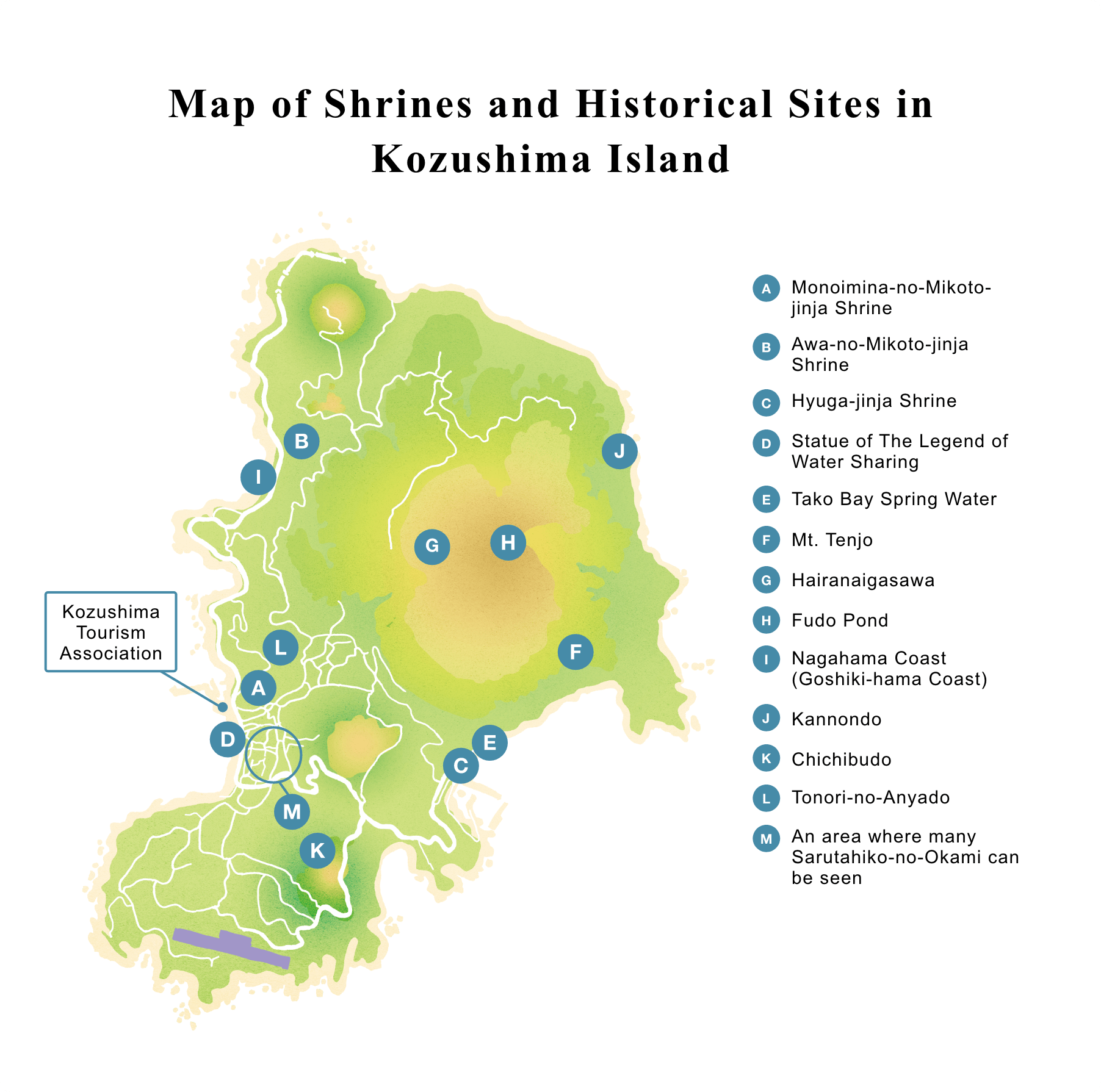
- Monoimina-no-Mikoto-jinja Shrine
- Awa-no-Mikoto-jinja Shrine
- Hyuga-jinja Shrine
- Statue of The Legend of Water Sharing
- Tako Bay Spring Water
- Mt. Tenjo
- Hairanaigasawa
- Fudo Pond
- Nagahama Coast(Goshiki-hama Coast)
- Kannondo
- Chichibudo
- Tonori-no-Anyado
- An area where many
Sarutahiko-no-Okami can be seen


